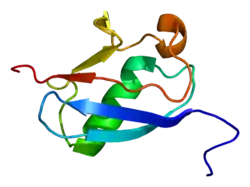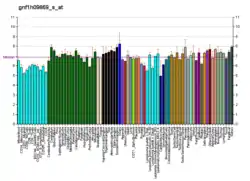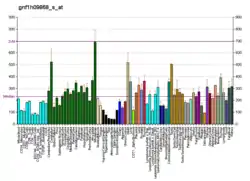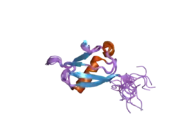UBL4A
Ubiquitin-like protein 4A is a protein that in humans is encoded by the UBL4A gene.[5][6][7]
References
- GRCh38: Ensembl release 89: ENSG00000102178 - Ensembl, May 2017
- GRCm38: Ensembl release 89: ENSMUSG00000015290 - Ensembl, May 2017
- "Human PubMed Reference:". National Center for Biotechnology Information, U.S. National Library of Medicine.
- "Mouse PubMed Reference:". National Center for Biotechnology Information, U.S. National Library of Medicine.
- Toniolo D, Persico M, Alcalay M (Mar 1988). "A "housekeeping" gene on the X chromosome encodes a protein similar to ubiquitin". Proc Natl Acad Sci U S A. 85 (3): 851–5. doi:10.1073/pnas.85.3.851. PMC 279653. PMID 2829204.
- Yang F, Skaletsky H, Wang PJ (Nov 2006). "Ubl4b, an X-derived retrogene, is specifically expressed in post-meiotic germ cells in mammals". Gene Expr Patterns. 7 (1–2): 131–6. doi:10.1016/j.modgep.2006.06.002. PMC 1647293. PMID 16872915.
- "Entrez Gene: UBL4A ubiquitin-like 4A".
Further reading
- Olsen JV, Blagoev B, Gnad F, et al. (2006). "Global, in vivo, and site-specific phosphorylation dynamics in signaling networks". Cell. 127 (3): 635–48. doi:10.1016/j.cell.2006.09.026. PMID 17081983.
- Kim SC, Sprung R, Chen Y, et al. (2006). "Substrate and functional diversity of lysine acetylation revealed by a proteomics survey". Mol. Cell. 23 (4): 607–18. doi:10.1016/j.molcel.2006.06.026. PMID 16916647.
- Gerhard DS, Wagner L, Feingold EA, et al. (2004). "The Status, Quality, and Expansion of the NIH Full-Length cDNA Project: The Mammalian Gene Collection (MGC)". Genome Res. 14 (10B): 2121–7. doi:10.1101/gr.2596504. PMC 528928. PMID 15489334.
- Strausberg RL, Feingold EA, Grouse LH, et al. (2003). "Generation and initial analysis of more than 15,000 full-length human and mouse cDNA sequences". Proc. Natl. Acad. Sci. U.S.A. 99 (26): 16899–903. doi:10.1073/pnas.242603899. PMC 139241. PMID 12477932.
- Chen EY, Zollo M, Mazzarella R, et al. (1997). "Long-range sequence analysis in Xq28: thirteen known and six candidate genes in 219.4 kb of high GC DNA between the RCP/GCP and G6PD loci". Hum. Mol. Genet. 5 (5): 659–68. doi:10.1093/hmg/5.5.659. PMID 8733135.
- Toniolo D, Persico MG, Battistuzzi G, Luzzatto L (1985). "Partial purification and characterization of the messenger RNA for human glucose-6-phosphate dehydrogenase". Mol. Biol. Med. 2 (2): 89–103. PMID 6533418.
This article is issued from Wikipedia. The text is licensed under Creative Commons - Attribution - Sharealike. Additional terms may apply for the media files.








